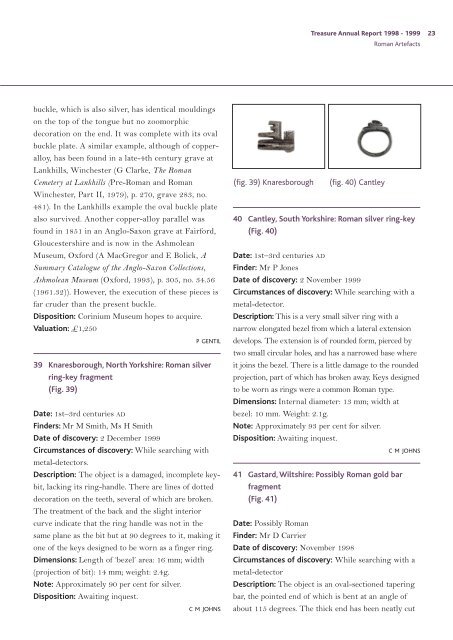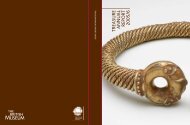Treasure Annual Report 1998-1999 - Portable Antiquities Scheme
Treasure Annual Report 1998-1999 - Portable Antiquities Scheme
Treasure Annual Report 1998-1999 - Portable Antiquities Scheme
Create successful ePaper yourself
Turn your PDF publications into a flip-book with our unique Google optimized e-Paper software.
uckle, which is also silver, has identical mouldings<br />
on the top of the tongue but no zoomorphic<br />
decoration on the end. It was complete with its oval<br />
buckle plate. A similar example, although of copperalloy,<br />
has been found in a late-4th century grave at<br />
Lankhills, Winchester (G Clarke, The Roman<br />
Cemetery at Lankhills (Pre-Roman and Roman<br />
Winchester, Part II, 1979), p. 270, grave 283, no.<br />
481). In the Lankhills example the oval buckle plate<br />
also survived. Another copper-alloy parallel was<br />
found in 1851 in an Anglo-Saxon grave at Fairford,<br />
Gloucestershire and is now in the Ashmolean<br />
Museum, Oxford (A MacGregor and E Bolick, A<br />
Summary Catalogue of the Anglo-Saxon Collections,<br />
Ashmolean Museum (Oxford, 1993), p. 305, no. 34.56<br />
(1961.32)). However, the execution of these pieces is<br />
far cruder than the present buckle.<br />
Disposition: Corinium Museum hopes to acquire.<br />
Valuation: £1,250<br />
P GENTIL<br />
39 Knaresborough, North Yorkshire: Roman silver<br />
ring-key fragment<br />
(Fig. 39)<br />
Date: 1st–3rd centuries AD<br />
Finders: Mr M Smith, Ms H Smith<br />
Date of discovery: 2 December <strong>1999</strong><br />
Circumstances of discovery: While searching with<br />
metal-detectors.<br />
Description: The object is a damaged, incomplete keybit,<br />
lacking its ring-handle. There are lines of dotted<br />
decoration on the teeth, several of which are broken.<br />
The treatment of the back and the slight interior<br />
curve indicate that the ring handle was not in the<br />
same plane as the bit but at 90 degrees to it, making it<br />
one of the keys designed to be worn as a finger ring.<br />
Dimensions: Length of ‘bezel’ area: 16 mm; width<br />
(projection of bit): 14 mm; weight: 2.4g.<br />
Note: Approximately 90 per cent for silver.<br />
Disposition: Awaiting inquest.<br />
C M JOHNS<br />
<strong>Treasure</strong> <strong>Annual</strong> <strong>Report</strong> <strong>1998</strong> - <strong>1999</strong> 23<br />
(fig. 39) Knaresborough (fig. 40) Cantley<br />
Roman Artefacts<br />
40 Cantley, South Yorkshire: Roman silver ring-key<br />
(Fig. 40)<br />
Date: 1st–3rd centuries AD<br />
Finder: Mr P Jones<br />
Date of discovery: 2 November <strong>1999</strong><br />
Circumstances of discovery: While searching with a<br />
metal-detector.<br />
Description: This is a very small silver ring with a<br />
narrow elongated bezel from which a lateral extension<br />
develops. The extension is of rounded form, pierced by<br />
two small circular holes, and has a narrowed base where<br />
it joins the bezel. There is a little damage to the rounded<br />
projection, part of which has broken away. Keys designed<br />
to be worn as rings were a common Roman type.<br />
Dimensions: Internal diameter: 13 mm; width at<br />
bezel: 10 mm. Weight: 2.1g.<br />
Note: Approximately 93 per cent for silver.<br />
Disposition: Awaiting inquest.<br />
41 Gastard, Wiltshire: Possibly Roman gold bar<br />
fragment<br />
(Fig. 41)<br />
C M JOHNS<br />
Date: Possibly Roman<br />
Finder: Mr D Carrier<br />
Date of discovery: November <strong>1998</strong><br />
Circumstances of discovery: While searching with a<br />
metal-detector<br />
Description: The object is an oval-sectioned tapering<br />
bar, the pointed end of which is bent at an angle of<br />
about 115 degrees. The thick end has been neatly cut





